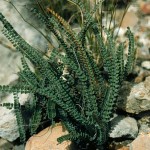Jimmyfern , Cochise Scaly Cloakfern
Cheilanthes cochisensis
Pteridaceae
Description
Cheilanthoid ferns are most commonly encountered in the arid southwest. Jimmyfern is an erect evergreen fern with compound, fernlike leaves. The erect stem emerges from short rhizomes and bears tan, linear, scales measuring 10 mm by 0.5 mm. The leaves usually are 7 to 20 cm but can grow up to 40 cm tapering toward the tip. The numerous leaflets (20 to 50 pairs) are so scaly beneath that the surface is completely obscured. The leaflets also have sparse star-shaped hairy scales above. The leaflets are oblong, sometimes with lobes having shallow indentations. The leaves originate from a short, woody stem. This is a "resurrection" plant: the leaflets roll up and become quite dry when moisture is lacking. They unroll and appear green and fresh after the rain.Habitat
Jimmyfern grows on rocky slopes and crevices, often closely associated with grasses characteristic of dry habitats. Common in the Trans-Pecos, it also occurs in the Plains and Edwards Plateau regions of Texas. It extends into New Mexico, Arizona, and south to Mexico.Toxic Agent
The toxic agent in Jimmyfern is unknown. The poison is excreted in milk and is not destroyed when the plant dries. Jimmyfern poisoning occurs in sheep, goats, and cattle. A trembling reaction called "the jimmies" develops about 48 hours after animals are fed as much as 0.5 percent of their body weight in the fern and are exercised. Animals generally must walk 10 to 60 minutes to develop signs. The danger of Jimmyfern poisoning is greatest in wet years from mid-November through February when other forage is dry, and the evergreen fern remains succulent and relatively palatable.Signs of Livestock Ingestion
Animals poisoned with Jimmyfern show these clinical signs: - Failure to keep up with the herd or flock - Stilted, uncoordinated gait - Arched back - Violent trembling (the jimmies) - Rapid heartbeat and breathing - Prostration Further exercise may bring on a fatal attack. Characteristically, in the last attack, the animal takes three or four stilted steps, drops, gasps a few breaths and dies almost immediately of respiratory paralysis.Management Strategies
No specific treatment is known. Sheep and goats usually do not recover after eating a lethal dose of Jimmyfern. Cattle tremble but usually live. Nonfatal cases require 5 to 19 days to recover. Under range conditions, it is important to leave poisoned sheep strictly alone during the danger period because any excitement or exercise aggravates their condition. Because most deaths occur in the winter, supply enough forage or supplemental feed to animals in an infested pasture during this period. Under severe conditions, move animals from pastures where Jimmyfern is abundant in winter before additional losses occur. Because of the habitat where Jimmyfern typically grows, herbicidal control with spot applications is difficult and generally unjustified. Provide ample watering places in pastures where Jimmyfern grows, so that animals can drink conveniently.Images
Plant Characteristics
Seed Type: Non-Encapsulated
Duration: Perennial
Stem Texture: Hairless/Smooth
Growth Habit: Forbs/Broadleaf
Leaf Shape
 : Pinnately Compound
: Pinnately Compound
Season: Evergreen
Distribution
 : 07 - Edwards Plateau, 08 - Rolling Plains, 09 - High Plains, 10 - Trans-Pecos
: 07 - Edwards Plateau, 08 - Rolling Plains, 09 - High Plains, 10 - Trans-Pecos
Distributions
Distribution refers to the ecological region in Texas that a plant has been found. You can also view a clickable map.
Book: Toxic Plants of Texas (B-6105)
Collection: Toxics
Livestock Affected: Cattle, Goats, Sheep
Livestock Signs: Abnormal Heartbeat, Arched Back, Depression/ Weakness, Incoordination, Irregular Breathing, Stiffness



